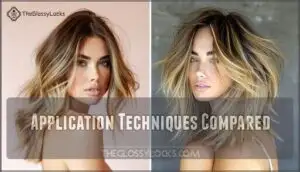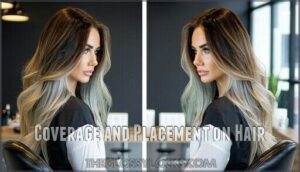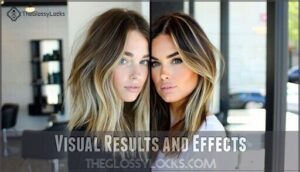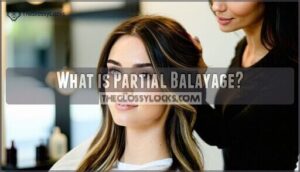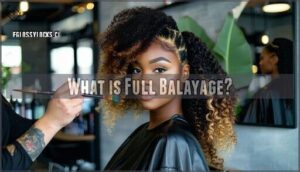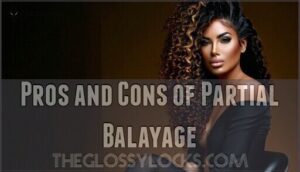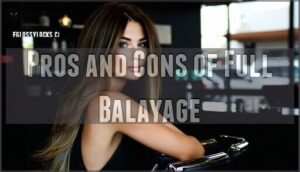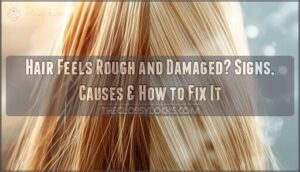This site is supported by our readers. We may earn a commission, at no cost to you, if you purchase through links.
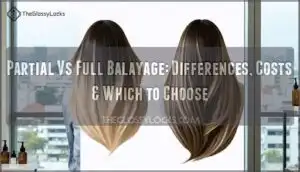
Partial balayage targets 30-50% of your hair with strategic hand-painted highlights around your face and surface layers, creating that natural sun-kissed effect. Full balayage covers 80-100% of your head with dimensional color layered through every section, delivering bold multi-tonal drama from roots to ends.
The difference isn’t just about how much hair gets painted—it’s about the vibe you’re chasing, the damage you’re willing to risk, and whether you’d rather spend 45 minutes or three hours in the chair. Your choice between partial balayage vs full balayage hinges on your lifestyle, maintenance tolerance, and how dramatically you want to transform your look.
Table Of Contents
- Key Takeaways
- Partial Balayage Vs Full Balayage: Key Differences
- What is Partial Balayage?
- What is Full Balayage?
- Time, Cost, and Upkeep for Each Option
- Pros and Cons of Partial Balayage
- Pros and Cons of Full Balayage
- How to Choose The Right Balayage for You
- Frequently Asked Questions (FAQs)
- What is Partial Foilyage?
- Are there any recommended products for color protection?
- Is Partial Balayage suitable for any hair type?
- Is there a cost difference between Partial Balayage and Full Balayage?
- Can balayage work on dark hair colors?
- How does balayage affect chemically treated hair?
- Whats the difference between balayage and ombre?
- Can you do balayage at home safely?
- Does balayage fade faster than traditional highlights?
- Conclusion
Key Takeaways
- Partial balayage targets 30-50% of your hair with strategic highlights around your face and surface layers, costing $76-$200 and requiring touch-ups every 12-16 weeks, making it ideal if you want a subtle sun-kissed look with minimal maintenance and lower damage risk.
- Full balayage covers 80-100% of your entire head with hand-painted highlights through every layer, costing $150-$452 and demanding salon visits every 10-12 weeks, delivering bold multi-dimensional color that shows in updos and completely transforms your look.
- The choice between partial and full balayage depends on your lifestyle, budget tolerance, and transformation goals—partial works for low-maintenance clients testing color changes, while full suits those committed to dramatic results and regular upkeep.
- Both techniques use similar lighteners and fade at comparable rates, but full balayage requires significantly more time (2-3 hours vs 45-60 minutes), more product, and higher investment in color-safe maintenance products to protect your transformation.
Partial Balayage Vs Full Balayage: Key Differences
Choosing between partial and full balayage isn’t just about the number of highlights—it’s about understanding how each technique transforms your hair differently. The application method, coverage area, and final look vary markedly between the two options.
Here’s what sets them apart.
Application Techniques Compared
The main difference between partial and full balayage comes down to where your colorist places those hand-painted highlights—and honestly, that one choice completely changes the technique, the time in the chair, and your final look.
Partial balayage uses a sweeping technique on targeted zones—usually the top layers and face-framing sections—while full balayage involves dimensional layering throughout every section of your hair.
| Technique Aspect | Partial Balayage | Full Balayage |
|---|---|---|
| Lightener Application | Strategic hair painting on select sections | Complete coverage with balayage hair techniques |
| Color Placement | Concentrated at face-framing areas and surface layers | Distributed through all layers and angles |
| Hair Highlighting Approach | Minimal product, maximum impact | All-encompassing dimensional effect |
Coverage and Placement on Hair
Once your colorist starts hair sectioning, you’ll see how hair mapping changes everything—partial balayage zeroes in on 30–50% of your hair, painting color placement around your face and crown, while full balayage works through 80–100% of every layer for complete dimensional layering across all quadrants. Understanding the hair lightening process is essential for achieving the desired look.
| Coverage Detail | Partial Balayage | Full Balayage |
|---|---|---|
| Surface Area | 30–50% targeted zones | 80–100% full coverage |
| Primary Zones | Top layer, face-framing | Crown to nape, all layers |
| Underlayers | Untouched for depth | Painted for uniform gradient |
| Hair Highlighting Focus | Strategic, sun-kissed effect | Complete multi-tonal transformation |
| Balayage Techniques | Concentrated sweeping | Systematic hand-painting throughout |
Visual Results and Effects
Beyond coverage, you’ll notice how color dimension separates these two—partial balayage creates a sun-kissed effect with highlights concentrated where light naturally hits, giving you softer contrast and a natural look that blends seamlessly with your base. Full balayage delivers bold, multi-tonal hair texture from root to tip, with highlight placement throughout every layer for dramatic dimension that transforms your entire head. Understanding the hair coloring technique is essential to making an informed decision between partial and full balayage.
| Visual Effect | Partial Balayage | Full Balayage |
|---|---|---|
| Color Dimension | Subtle, concentrated brightness | Bold, all-over transformation |
| Contrast Level | Soft, natural blend | High-impact, dramatic |
| Hair Texture Appearance | Sun-kissed surface glow | Multi-dimensional depth throughout |
| Overall Finish | Face-framing radiance | Complete color overhaul |
| Hair Highlighting Methods | Strategic accent painting | Full tonal shift |
What is Partial Balayage?
Partial balayage is a targeted highlighting technique that gives you a sun-kissed look without committing to a full head of color. It focuses on specific sections—usually the top layer and face-framing pieces—for a subtle, natural effect.
Here’s what makes partial balayage work and who it’s perfect for.
Process and Placement
With partial balayage, your colorist zeroes in on specific zones—think face-framing pieces or just the top layer—hand-painting highlights where they’ll make the biggest impact without touching every strand. Here’s how the process unfolds:
- Hair sectioning isolates the top layer or perimeter strands you want brightened
- Color placement targets ends and mid-lengths, leaving roots naturally darker
- Highlight techniques involve sweeping motions that mimic sun-lightened hair
- Balayage patterns focus on visible areas rather than underneath layers
- Styling methods blend the look seamlessly once you’re done
Ideal Hair Types and Lengths
Who thrives with partial balayage? If you’ve got shoulder-length or longer hair with medium to thick texture, you’re looking at ideal territory—the length gives your colorist room to create gradual color depth transitions, while thicker hair type holds highlights without excessive damage risks.
Fine hair works too, though you’ll want fewer foils to protect hair health.
Styling options multiply when your base has enough canvas for contrast, making partial balayage perfect for testing the waters before committing to full balayage.
Popular Partial Balayage Looks
Face-framing brightness, sun-kissed ends, and money piece magic—these are the go-to moves that make partial balayage such a crowd-pleaser. The money piece—thick, bold highlights flanking your face—draws focus without committing to full-head coverage.
If you’re chasing dimensional looks with minimal upkeep, ask your stylist about babylights blended into ends or ribbon highlights through mid-lengths. These hair painting techniques deliver current hair color trends while keeping your natural base intact.
What is Full Balayage?
Full balayage takes your hair color to the next level by transforming your entire head with hand-painted highlights. This approach covers every section and layer, creating a bold, dimensional look that’s far from subtle.
Let’s break down what makes full balayage the premier choice for anyone ready to make a statement.
Process and Full-Head Coverage
Full balayage turns your entire head into a canvas, with your colorist hand-painting highlights through every section and layer from root to tip. This full coverage approach demands systematic hair sectioning and strategic color placement:
- Your stylist divides hair into multiple zones for complete access
- Lightener gets swept through underlayers, not just surface strands
- Hair painting extends from nape to crown, reaching every angle
- Balayage techniques adapt thickness and saturation per section
- The process delivers all-over dimension that partial balayage can’t match
Dramatic Transformation Results
You’re looking at a color shift that doesn’t whisper—it shouts, delivering bold contrast and noticeable lightness that completely redefines your look.
Full balayage creates a dramatic hair change through vibrant highlights that bring serious dimensional depth—think hair transformation that catches light from every angle.
This isn’t subtle hair revival; it’s a complete style evolution that gives you that head-turning, unapologetic vibe you’ve been craving.
Best Candidates for Full Balayage
If you’re ready to make your hair color as bold as your lifestyle, full balayage is your power move—but it’s not for everyone. This dimensional look works best when your hair can manage the transformation and your routine accommodates the upkeep. Here’s who should go for it:
- Medium to long hair lengths (72% of full balayage clients have shoulder-length or longer hair, where color depth really pops)
- Anyone wanting visible highlights in updos (full balayage covers every layer, so your color shows whether hair’s down or in a ponytail)
- Those seeking 3-4 levels lighter than their natural hair color for serious transformation
- Clients with healthy hair texture and low hair porosity (damage risk increases with full-head hair coloring, so strong strands are essential)
- People committed to 8-12 week touch-ups and quality hair styling products to protect their investment
Time, Cost, and Upkeep for Each Option
Before you commit to a color, let’s talk numbers. The time you’ll spend in the chair, what you’ll pay, and how often you’ll need to come back all depend on which route you choose.
Here’s what to expect for each option.
Appointment Duration
Time is money, and regarding balayage, your schedule matters just as much as your budget. Partial balayage usually takes 45 minutes to an hour—perfect for a quick transformation during lunch.
Full balayage demands more session length, usually two to three hours, since color processing covers every layer. Factor in wait times for appointment scheduling, especially with experienced colorists who know their balayage techniques inside out.
Price Ranges and Factors
Balayage pricing varies significantly depending on the type of service you’re seeking. Partial balayage typically costs $76 to $200, while a full balayage can range from $150 to $452. This substantial difference reflects the additional time and product required for a full balayage.
Price factors that shift your total:
- Hair length and thickness—longer, denser hair demands more lightener and processing time, pushing stylist fees higher.
- Regional variations—major cities charge premium rates compared to suburban salons, sometimes doubling the base price.
- Colorist experience—seasoned specialists command higher fees but often deliver excellent results with less damage.
Your natural hair color and history also play a role in determining the final cost. Darker bases, for instance, require more product to achieve the desired lift.
Maintenance and Touch-Up Schedule
Once you’ve locked in your balayage, here’s the reality check: partial balayage usually needs touch-ups every 12 to 16 weeks, while full balayage requires salon visits every 10 to 12 weeks due to more noticeable hair regrowth and color fading.
Your hair maintenance requirements depend heavily on contrast—platinum or high-contrast styles demand touchups every 6 to 8 weeks to prevent harsh root lines, while subtle, low-contrast looks stretch maintenance costs and let you skip appointments for up to four months between sessions.
Pros and Cons of Partial Balayage
Partial balayage isn’t a one-size-fits-all solution, and it comes with trade-offs you’ll want to weigh before committing.
Understanding the advantages and limitations helps you decide if this technique aligns with your hair goals and lifestyle.
Here’s what you need to know about choosing the partial route.
Hair Health and Damage Risk
One advantage of partial balayage is the reduced chemical damage compared to full-head applications. Since only 20–50% of your hair is treated, you’ll face lower breakage risk and fewer issues with split ends prevention.
This method minimizes hair porosity changes and helps with hair damage prevention overall. Your hair maintenance routine stays simpler, and color fading is less noticeable.
It’s solid hair health advice for anyone prioritizing hair care and maintenance without sacrificing style.
Subtlety and Natural Appearance
Beyond the health benefits, partial balayage delivers that relaxed, sun-kissed look without screaming “I just came from the salon.” The subtle highlights blend seamlessly with your hair texture, creating dimensional layers that amplify natural color depth.
You’ll get that multidimensional hair effect—dimensional without the drama—keeping your natural-looking hair intact. It’s the sunkissed effect that works with your natural look, not against it.
Suitability for Low-Maintenance Routines
If you’re the type who’d rather spend Saturday mornings anywhere but a salon chair, partial balayage fits perfectly into your easygoing routine. Touch-ups stretch to 3-4 months between visits, and color preservation is simple—no complex routine care needed.
Your hair texture stays healthier with this low-maintenance color approach. Quick styling tips? Air-dry and go. That’s the freedom partial balayage delivers compared to full balayage’s demanding upkeep schedule.
Pros and Cons of Full Balayage
Full balayage offers a head-turning transformation, but it’s not without trade-offs. You’ll get more color, more dimension, and more styling freedom—but you’ll also face higher costs and more frequent salon visits.
Here’s what you need to know before committing to this all-over approach.
Boldness and Versatility
Full balayage doesn’t just add color—it gives you the freedom to completely reinvent your look with highlights that sweep through every layer and section of your hair. You can go darker at the roots and lighter at the ends, play with color depth for dimensional looks, or amplify your hair texture with strategically placed highlights.
The styling options are endless—whether you’re rocking beachy waves or sleek straight hair, full balayage conforms to whatever vibe you’re channeling.
Upkeep Demands
Let’s be real—full balayage demands commitment. You’ll need salon visits every 12 to 14 weeks for touch-ups, and color fading becomes noticeable around the 3- to 6-month mark.
Hair regrowth shows more dramatically across every layer, so your hair maintenance requirements increase. Maintenance costs add up, too—expect $150 to $400 per session, plus toner applications.
Your hair care routine needs sulfate-free products, heat protectants, and monthly masks to keep things vibrant.
Customization for Dramatic Changes
Want to turn heads and completely reinvent your look? Customization is what separates full balayage from a cookie-cutter color job. Your stylist can weave custom highlights through every layer, adjusting placement for your hair texture and face shape.
This hair transformation creates dimensional layers that shift with movement—blonde ribbons, caramel undertones, or ash tones blended exactly how you want. Full balayage gives you complete color enhancement control, unlike partial balayage’s focused approach.
How to Choose The Right Balayage for You
Choosing between partial and full balayage isn’t about following rules—it’s about what works for your hair, your schedule, and the look you’re after. The right choice depends on your goals, how much time you can commit to maintenance, and what you discuss with your colorist.
Here’s what to think about before you book that appointment.
Assessing Your Hair Goals
Before you commit to partial or full balayage, you need to get crystal clear on what you’re actually trying to achieve with your hair color. Ask yourself: do you want a soft, sun-kissed glow or a head-turning transformation?
Your hair type analysis, face shape, skin tone, and personal style all play into this decision. Partial balayage works for subtle dimension, while full balayage delivers bolder color preference results throughout your entire head.
Lifestyle and Maintenance Considerations
Your dream hair color means nothing if you can’t keep up with the upkeep—and that’s where most people get blindsided. Think about your daily hair routine and whether you’re willing to adjust it for color preservation and damage control:
- Weekly wash frequency affects color fading and hair maintenance schedules
- Heat styling habits require extra product selection for protection
- Budget for quality shampoos and styling tips that prevent brassiness
- Time for deep conditioning treatments maintains low-maintenance color results
- Lifestyle factors like swimming or sun exposure impact hair care needs
Consultation Tips for Salon Visits
Walking into that salon chair unprepared is like showing up to a tattoo artist with no idea what you want—you’ll either walk out disappointed or with something you didn’t ask for. Bring hair color inspiration photos for clear communication during your hair consultation.
Discuss client expectations, your hair history, and maintenance willingness—effective salon etiquette means honest answers during the consultation process.
A thorough hair analysis determines whether partial or full balayage suits your base color and lifestyle.
Frequently Asked Questions (FAQs)
What is Partial Foilyage?
Foilyage combines balayage’s hand-painting with traditional foil techniques for controlled color placement. Stylists apply highlights using the sweeping balayage method, then wrap sections in foil to intensify lift and create a more dimensional look with richer tones.
Are there any recommended products for color protection?
Color safe shampoos and sulfate free products are essential for protecting balayage, while weekly hair masks and moisturizing treatments keep your hair healthy.
Your colorist can recommend specific color protectants that combat brassiness and extend vibrancy between appointments.
Is Partial Balayage suitable for any hair type?
Picture a client with fine, straight hair wondering if she can rock the same sun-kissed look as her curly-haired friend. Partial balayage works beautifully across all hair types—from thick to thin, straight to coily.
Hair texture affects how highlights catch light, while color depth determines contrast. Damage risk stays lower than full coverage, and styling options remain adaptable with proper maintenance tips.
Is there a cost difference between Partial Balayage and Full Balayage?
Yes—partial balayage costs less than full balayage. Full balayage ranges from $76 to $452, while partial usually runs lower since it covers fewer sections and requires less product and time, making it budget-friendly.
Can balayage work on dark hair colors?
Balayage absolutely works on dark hair colors, creating rich caramel, honey, or chocolate tones. Dark shade options like deep bronze or auburn add dimension without drastic color correction, though hair toning helps perfect the final look.
How does balayage affect chemically treated hair?
Chemically treated hair has higher porosity and increased breakage risk, making balayage more challenging.
The hair lightening process can worsen existing chemical damage, leading to faster color fading and compromised treatment outcomes if not managed carefully.
Whats the difference between balayage and ombre?
Ombre creates blocks of color that shift from dark roots to lighter ends, while balayage uses hand-painting methods for a softer, more natural blend throughout your hair.
Can you do balayage at home safely?
While at-home kits exist, DIY balayage carries serious risks. The freehand technique demands precision you can’t achieve solo.
Improper application leads to patchy results, chemical burns, or severe damage. Safety precautions matter—leave balayage to professionals for beautiful, healthy hair.
Does balayage fade faster than traditional highlights?
Actually, balayage doesn’t fade faster than traditional highlights—both use similar lighteners and follow comparable fading timelines.
Color longevity depends more on hair porosity, maintenance routines, and balayage maintenance practices than the application technique itself.
Conclusion
Your hair isn’t a canvas for someone else’s vision—it’s yours. Whether you lean toward partial balayage vs full balayage, whether you crave low-key dimension or jaw-dropping transformation, the choice reflects how you want to move through the world.
Partial gives you sun-kissed ease without the salon marathon. Full delivers head-turning depth that demands attention. Both work, both shine—but only one matches your rhythm, your risk tolerance, and the version of yourself you’re building today. Choose accordingly.
- https://www.lorealprofessionnel.com/int/concern-hair-colour/how-to-take-care-of-balayage-hair
- https://walkindermatology.com/will-hair-dye-cause-my-hair-to-fall-out/
- https://straitsresearch.com/report/hair-color-market
- https://scandinavianbiolabs.com/blogs/journal/hair-dye-statistics
- https://hastehair.com/full-balayage-vs-partial-balayage/

